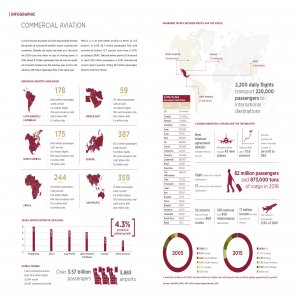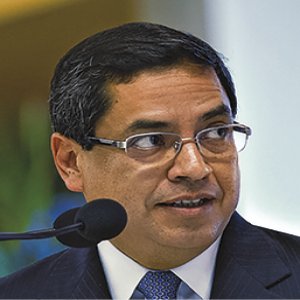Business Destinations Open Opportunity

STORY INLINE POST
Q: How big a factor is Mexico in United Airlines’ long-term sales strategy?
A: Mexico is United Airlines’ second-biggest market in terms of operations outside the US. We operate flights to 64 destinations in Latin America and the Caribbean with an average of 1,000 flights a week. Of these, 550 are to Mexico. Mexico City is the only destination connected with all seven hubs in the US: Houston, Denver, San Francisco, Los Angeles, Chicago, Newark and New York.
United Airlines continuously analyzes its routes to determine when to increase capacity. When we notice growth in demand in a market, we either schedule more flights for this destination or use a larger aircraft. For instance, five years ago we started flying seven times a day from Monterrey to Houston. As demand grew we added five more flights for a total of 12 daily flights in this route and one in the Monterrey-Chicago route. Shortly after, we started to operate 14 weekly flights. United flew 70-seat CRJ-700 airplanes in this market but as demand grew, we replaced these aircraft with the 76-seat Embraer E-175. This measure meant an increase of almost 10 percent in the number of available seats per flight.
Q: What are the most important routes for United in Mexico?
A: Cancun is our busiest airport outside the US. During peak season, we operate up to 40 daily flights. In Mexico City, we have up to 16 flights a day and all our operations are mainline flights. In Queretaro, we fly three daily flights using 76-seat ERJ175 aircraft and in Leon we grew from a daily flight to Los Angeles and four to Houston to four flights to Houston and two to Los Angeles. Last year, United added a new flight to the Aguascalientes-Houston and San Luis Potosi-Houston routes. This was done largely to further connect the automotive industry as air traffic between Europe, Asia and the US related to this sector has grown. United Airlines used to partially operate its mainline flights using Airbus A319s, Boeing 737s and other large aircraft while operating a few flights using 76-seater regional jets. Now, all United Airlines’ flights are mainline and jets are used in other destinations.
Q: What are your growth expectations for flights between the US and Mexico in the long term?
A: The entire Latin American market continues to grow, not just Mexico. Of the 20 most important cities in Latin America, only 43 percent have a direct flight services, while 100 percent of the important European cities have these kinds of connections. The aviation industry in Latin America will grow more than in the rest of the world. The average growth of this industry in Latin America is 4.6 percent, while growth in the Mexican market is expected to be 4.7 percent. The agreement between the American and Mexican governments provides more options for flight destinations. Before this agreement existed, only two foreign airlines were allowed to fly to the same destination. Lifting this limitation will boost competition and provide customers with a greater number of options to choose from.
Q: What are United Airlines’ most important alliances and what does it look for in a partner?
A: United Airlines is a founding member of Star Alliance. But the company also has separate agreements with various airlines. We have a codeshare and frequent-flyer agreement with Aeromar that helps us take passengers to some destinations where we do not fly. Before this partnership, United Airlines had an average of 40 codeshare flights to 16 cities operated by Aeromar. Now, we have increased it to 74 codeshare flights to 20 cities. Partnering with these kinds of companies increases the number of destinations offered and the frequency of operations and makes air tariffs more competitive. Among Latin American companies, we also have codeshare and frequent-flyer program agreements with both Copa Airlines and Avianca.
We have joint ventures with Lufthansa and Air Canada. Passengers flying on any United Airlines, Air Canada or Lufthansa flight departing from any country from Canada to Panama and going to Europe, the Middle East, Africa or India can interchange flights between these three airlines at the same tariff, connect between each lines’ flights and have their luggage dispatched to their final destination. This means a passenger flying from Mexico to Europe will find a better price connecting between these companies’ flights. United Airlines also has a joint venture with Japan’s ANA for all flights over the Pacific to Asia. This provides passengers with more options and destinations when choosing a flight.
Q: What technology and aircraft is United Airlines interested in having in its fleet?
A: We are replacing our fleet, both wide-and narrow body aircraft. We are retiring our Boeing 747s and introducing more efficient and newer planes. Also, our 50-seat planes are being replaced with new Embraer E-175s. United also has several Boeing 737-900s and has placed an order for Boeing 737-MAX, Boeing 787-10, Boeing 777-300ER and Airbus A350 aircraft. All these new planes produce less environmental and noise pollution and have a greater flight range. Although the Boeing 747 is an iconic plane, its four engines make it much more expensive to operate than newer aircraft. In terms of technology, we are innovating in many of the planes we are refurbishing by introducing slim line seats but no screens. Passengers can connect to onboard internet and access to inflight entertainment (IFE) system from their own devices. Also, all planes with 70 and more seats have satellite onboard Wi-Fi. In terms of boarding passes, United Airlines has an app in which passengers can check in and scan their boarding pass, get notifications in their email or phone in case there is a delay or a gate change, as well as track their checked luggage.
Q: What are your plans to implement the Polaris business-class service in Mexico?
A: United Airlines invested over 12,000 hours in the development of this business-class product. All the seats in this class are bed-like and have direct access to the aisle so that passengers do not have to climb over each other to reach the aisle. We are not operating this type of aircraft to Mexico, but passengers connecting from Mexico at any of our hubs and who are flying intercontinental routes will experience this product as well as the Polaris lounges where available.
Q: What are passengers looking for when choosing United Airlines?
A: First of all, our network. Most United Airlines’ passengers are business travelers as 80 percent of our routes are to the main worldwide business centers. With the on-board Satellite WIFI, business passengers appreciate being able to connect anywhere they are so they can solve problems before arriving to their destination. In other segments, demand for certain services depends largely on the kind of passenger at hand. But all passengers regardless of the type want to reach their destination safely and to wait the minimal time possible.
Q: How is United Airlines facing the saturation of AICM and what does it expect from NAICM?
A: The number of slots at AICM is limited but United Airlines is fine with the number of slots it holds. Replacing smaller aircraft with bigger planes has enabled the airline to increase and even double capacity. For instance, changing from 75-seat aircraft to 146-seat planes almost doubles the number of available seats per flight. Also, increasing the number of operations and destinations from cities close to Mexico City, such as Puebla and Queretaro, reduces the need for customers who live there having to fly from Mexico City.
NAICM’s capacity will be valuable for the country as AICM is saturated and there are companies that want to fly to Mexico City but are unable to. NAICM will bring in more companies and more people, generating a trickle-down economic effect that will result in investment that benefits both Mexico City and the country. Its three air strips per terminal will enable more simultaneous take-offs and landings, permitting more flights to more destinations.
Q: What are United Airlines’ growth expectations in terms of cargo and passengers for 2017 and 2018?
A: Several industries in Mexico are growing, including automotive, technology, pharmaceutical, aeronautics and petrochemistry. Since growth is not focalized in a single industry, there are many opportunities for this to continue. United Airlines flies to all the business centers in which these industries are concentrated but we have limited cargo operations in some places because we only fly smaller aircraft to and from these destinations. As a result, we hire the services of a local company to move cargo by truck to airports where United Airlines works with larger aircraft. This enables us to boost the demand for cargo transportation by plane. In terms of passengers, United Airlines operated 1.6 million flights worldwide and transported over 143 million passengers in 2016. We expect the number of flights United Airlines operates in Mexico to grow beyond the current 550 flights a week as investments continue to arrive to Mexico.
























